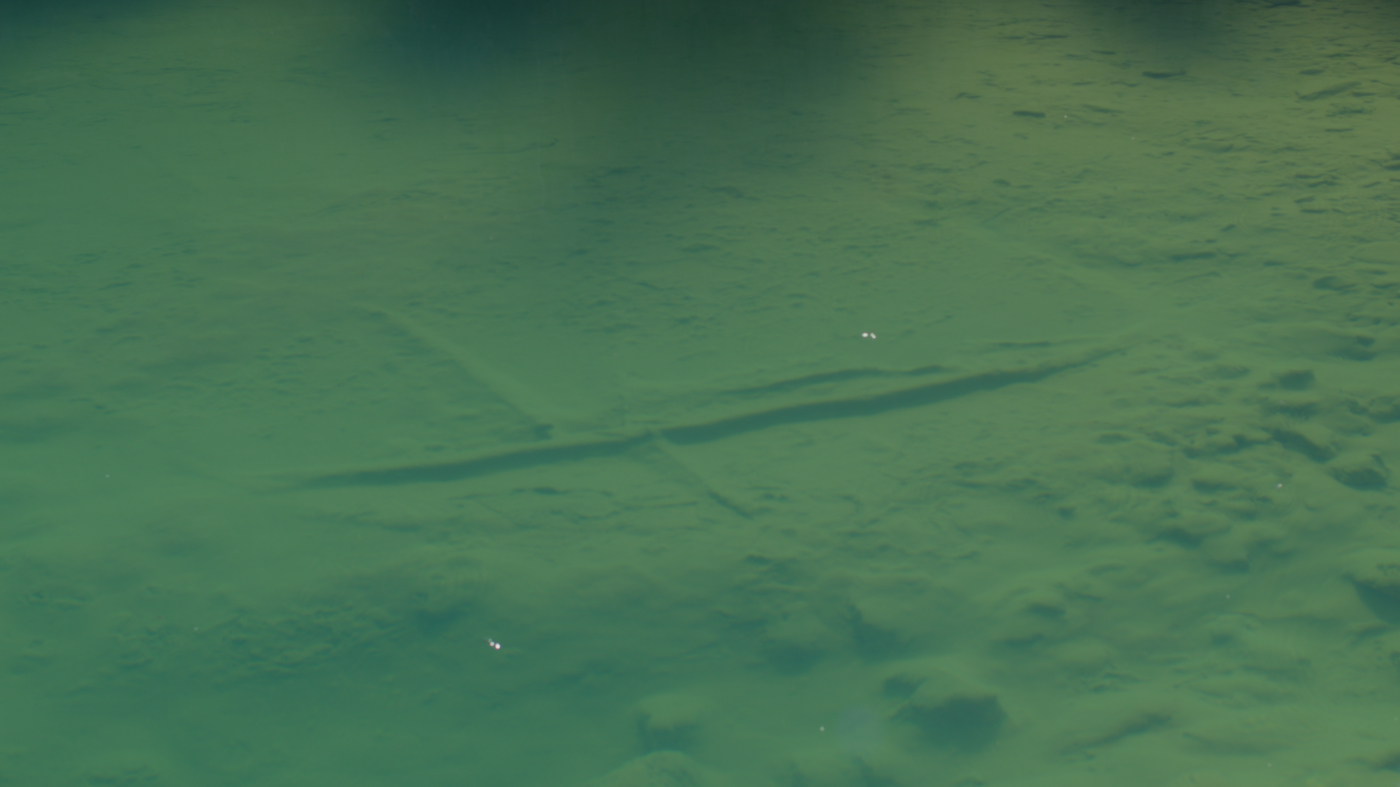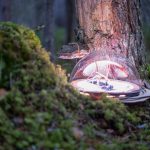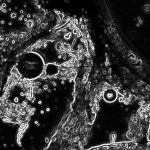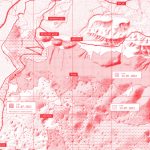Our planet is in crisis. Earth Gazes Back, a novel exhibition concept and part of Photo North’s international collaborative project More-than-Planet, invites us to explore the multiple crises threatening our world and to consider the possibilities of navigating an unknown future through the perceptions of artists, scientists and local people.
Human-induced climate change is already causing many extreme weather and climate events in all regions of the world.1 According to the United Nations’ Intergovernmental Panel on Climate Change (IPCC), rapid changes will have more devastating impacts than ever before, not only on the environment but also on the loss of people’s livelihoods, homes and communities. Climate change and geopolitical tensions have brought the material boundaries of societies to the fore.2 The window of opportunity to respond to the socio-ecological phenomena that deeply affect society is rapidly closing, but there is hope for a secure and viable future.
What kind of future do we have? In a world where 75% of the Earth’s surface is under direct human influence, the way we understand and describe the planet has a concrete impact on the environment itself. These perspectives are based on the many underlying concepts, value systems, visual cultures and technologies used to describe the Earth’s environment. However, these techniques are neither socially neutral nor inclusive.3 Earth Gazes Back asks: What is a planet? What is a forest? What is a mine or a backyard? What is the essence of the current environmental issues and how can environmental literacy help us understand it? What are the challenges for our future and how will these challenges manifest themselves? How and where do we get information and what makes it reliable? How can we use knowledge to do things differently and what kind of future do we dream of?
Despite technological advances, humans are still bound by the physical limitations of our senses. This also affects how we relate to time, physical scale and distances from nearby forests and rivers to the mainland, the planet, our solar system and the universe. What role, for example, might local knowledge and data from the depths of the Earth, satellite data and remote sensing play in describing our life forms? The works and projects in Earth Gazes Back take us on a journey from the depths of the bedrock and its diverse life forms to the space-atmosphere boundary, the Kármán Line, and from there to Mars and back. The artists featured in the exhibition are Baran Caginli, Cesar & Lois, Felicia Honkasalo, Mari Keski-Korsu, Kotryna Ula Kiliulyte, Minna Långström and Spektr Z & Marko Peljhan.
Minna Långström‘s three-channel video work Photons of Mars (2019), on view at Valve Gallery, invites us to explore questions of imaging and representation. Långström’s work explores interplanetary space research and the daily work of a Mars rover driver at NASA’s Jet Propulsion Laboratory. While not much happens on the serene dunes of Mars, a daily view of this remote place allows for a deeper understanding. The work explores how images shape our perception of Mars and shows how technology is blurring the line between reality and representation. Is it the case that we can only understand unfamiliar worlds through culturally charged images? The installation also includes a model of a Martian rock, the Jake Matijevic, in a display case. The rock, which was discovered on Mars in 2012, also features in the work. Because no single side of the rock has been photographed in detail, the model’s features are also rough.
From the surface of Mars, we move on to the Earth and the issues of borders and maps, open and censored data.Baran Caginli‘s Vacation in Greece (2020), comprising a sculptural work and satellite images, explores cartographic censorship in the Aegean Sea. Caginli’s work considers maps as highly political objects: as part of modern secrecy tactics, states use censorship as a key form of information. For example, due to the historical crises between Greece and Turkey, maps of Greece have been heavily censored. The sculpture on display is a photogrammetric and 3D printed model of the three-dimensional censored airport of Kefalonia, created from 6000 satellite images. In a series of photographs included in the work, the sea surrounding the islands is also pixelated – as it is in online maps. The roots of the censorship go back to the ongoing conflict between Greece and Turkey and the demands to change the maritime borders. In Caginli’s work, pixelated, blurred and altered images are used by states to define and blur places and people into nothingness.
The intersection of technology, environment and human experience is also interpreted by Spektr Z & Marko Peljhan in their Oculos Super Ignes Vigilantes Volavimus (2022). In July 2022, the largest forest fire in the country’s modern history broke out on the Karst plateau in Slovenia. The area is also the site of the 1915-1917 battle between the Kingdom of Italy and the Austro-Hungarian Empire, in which 1.5 million people died. This chilling figure is a reminder of the absurdity of this and the world’s modern military conflicts. The work explores the use of unmanned technology, remote sensing and military infrastructure outside the military context. On that July evening, the Spektr Z research laboratory, led by Marko Peljhan, was assisting the Defence Forces Air Traffic Control in coordinating the extinguishing of forest fires. Combining poetic imagination and tactical media as a tool, the work offers a perspective on the resilience of the human spirit and the power of technology in a world on the brink of collapse.
The More-than-Planet project leader, Waag Society’s Futurelab, has brought a participatory workshop concept called the Planetary Public Stack to the exhibition. The workshop will address the technologies and skills needed to develop innovative approaches based on collaboration and art, as well as critical and creative tools for thinking about and solving today’s environmental problems. The concept is primarily a tool for discussion, based on the idea that our planetary imaginaries, with their social-ecological implications, are fundamentally dependent on the technologies and infrastructures of our environment. The concept builds on Waag’s earlier project, Public Stack, which critically examined the use of our technologies and proposes a redesign of the technological layers of our society from the perspective of public values and concepts. The exhibition team has also produced a small handbook on environmental literacy from different perspectives to accompany the workshop.
The first workshop of Planetary Public Stack will take place as part of the Earth Gazes Back seminar on 24-25 September 2024. The workshop will be led by Miha Turšič, project director of the Waag Society. Information on future workshops will be published on the Photo North website.
The exhibition then takes us into the gallery space of Photo North – Northern Photography Centre to explore the forest, transhuman intelligence, and ecological and geological change on a human and planetary scale. The three-channel installation Boreal Intelligence (2024) by artist collective Cesar & Lois makes the internal sensing and biological communication of various subarctic species tangible. In the exhibition, enclosures equipped with electronic sensors tailored to the forest light up according to the pulse specific to each organism, such as fungi, mosses, lichens and pines. The work envisions an ecosystem AI that could transcend the human-centricity of algorithms and orient technology towards a multitude of models that enable life on Earth; instead of human-built machines, machine intelligence should learn from the forest. The work explores the forest as a network of intelligent organisms and offers an experience of the forest as an intelligent system. Boreal Intelligence is one of the works commissioned for the More-than-Planet project and produced as part of the Meander/Boreal Forest residency at Oulanka Research Station, Kuusamo.
The definition of forest and nature is also explored in Kotryna Ula Kiliulyte‘s work of photographic sculptures Forest Objects (2024). The installation-like ensemble also includes two video works from Kiliulyte’s series Arctic Swell (2022). Filmed with a drone in Finland, Lithuania and Scotland, the forest landscapes reflect on the definition of the forest over the last few hundred years. In Kiliulyte’s work, nature is not natural; the translucent exhibits contain photogrammetric distortions and collages designed to disrupt the landscape, while the video works reflect on symbiotic relationships and question human’s relationship with nature. By looking at the landscape through technological enhancements, we also shape it – yet it shines and changes. There is a lot of reinterpreted data, but is there a hint of pine in the air? And is there a soft yellow streak of pollen on your cheek? I wonder if the ants have woken up after a long winter.
From the forests we move to more industrial landscapes to reflect on the geological evolution of the earth, mining and the local and specific history of metallurgy. Felicia Honkasalo‘s video Spectral Matter (2024) is set in the town of Pyhäjärvi, which owes its existence to the operation of the Pyhäsalmi Mine. By extracting and refining the earth’s ancient mineral wealth, these industries have not only driven technological development and economic growth, but also created a global trade network linking distant regions through the exchange of metals and natural resources – a process that has shaped the way our societies and cultures function and are structured. This dark drive for profit is altering the landscape, disrupting ecosystems and accelerating natural geological change on a planetary scale. Honkasalo highlights humanity’s profound capacity to transform the planet, tracing the complex links between local actions and global consequences, and illuminating the intertwining of human desire and geological history. Spectral Lands is the second work commissioned for the More-than-Planet project and was created as part of the Deep residency at Pyhäsalmi Mine.
The final work in the exhibition, Walks in the Steam of Cryosphere (2024) by Mari Keski-Korsu, takes the viewer into a world of rituals that transcend the human. Keski-Korsu uses folk healing and walking as forms of ritualisation through intuitive, caring and empathic acts. The exhibition focuses on the changing state of the permafrost in the Arctic palsa bogs and the ancient microbial life released from the ice as a result of the climate crisis. Microbes frozen in permafrost for millennia may pose a threat to modern life, but could the permafrost thaw also act as a source of healing and resilience for the modern age? Keski-Korsu suggests that walking as a bodily ritualisation of everyday life can be combined with the experience of the icicle, and that the microscopic life of the icicle can be encountered in the sauna-based folk healing treatments. The artist has recorded her encounters in the sauna in an archive that brings together samples of peat, sweat and melting ice from various bodies. Visitors to the exhibition can take some melted ice home for their own sauna experiments – at their own risk.
____
Combining satellite data, artistic research, citizen science and photography, the international More-than-Planet project builds capacity for a richer planetary understanding and aims to develop environmental literacy for all – artists, scientists and citizens.
The exhibition will be accompanied by a two-day Earth Gazes Back seminar on 24-25 September 2024 at the Valve Culture Centre. Some of the artists in the exhibition will be present to talk about their work and the projects on display. In addition, we will have access to the works in the exhibition, their histories and wider social and political contexts through Photo North’s publication Earth Gazes Back, to be published in autumn 2024.
More-than-Planet: Earth Gazes Back is a part of Oulu 2026 -program.
More-than-Planet project partners include the Waag Society in the Netherlands, the Ars Electronica Centre in Austria, Leonardo/Olats and Makery in France, and Project Atol in Slovenia. Local partners include the University of Oulu’s Oulanka Research Station and the Callio Lab research and testing organisation in the Pyhäsalmi mine (part of Kerttu Saalasti Institute, University of Oulu).
The international research project More-than-Planet will develop environmental literacy through space exploration, artistic work and collaboration between 2022 and 2025. The project has received Creative Europe funding under the programme code 101056238 and national funding from the City of Oulu and the Finnish National Board of Education.
_____
1 The Intergovernmental Panel on Climate Change (IPCC), The United Nations 2023, https://www.ipcc.ch/
2 BIOS 2024, https://bios.fi/info/
3 More-than-Planet, https://www.more-than-planet.eu/
_____
Earth Gazes Back
Baran Caginli, Cesar & Lois, Felicia Honkasalo, Mari Keski-Korsu, Kotryna Ula Kiliulyte, Minna Långström and Spektr Z & Marko Peljhan
September 25, 2024 – January 19, 2025
Valve Gallery & Photo North – Northern Photography Centre
Guided Tours
13.10.2024 2PM
24.11.2024 2PM
14.12.2024 2PM
11.1.2025 2PM
Image from Felicia Honkasalo: Spectral Matter (2024)



